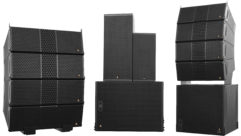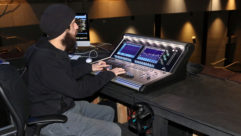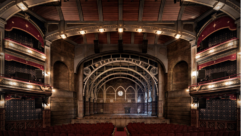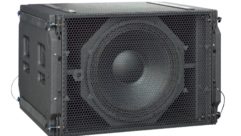

Compact Line-array Systems
Sep 29, 2010 12:00 PM,
By Mark Johnson
Compact systems composed of 8in. or smaller low-/mid-frequency drivers.
Alcons Audio LR16
Everything old is new again. Look around and you’ll see movie remakes and new car models that look like classic versions. And then there are line-array loudspeaker systems. The theory and the basic technology behind line arrays is old news; the implementation is today’s news. Surely every old guy in audio has fond memories of Shure’s Vocal Master or even the old Bogen column speakers. Fast-forward to the current implementation: individual cabinets with one or two LF/mid drivers, a mid/high arrangement of some kind, and then a high-frequency section, stacked or suspended to form a line array. For the high-frequency section, many of the systems employ some type of waveguide that was developed as the result of extensive R&D. And there are systems that offer digital steering of the beam.
The benefits of line arrays are well-defined coverage in both the horizontal and vertical planes and good coverage over distance. Line arrays exhibit a 3dB drop off per doubling of distance as opposed to the 6dB drop off of conventional point-source systems. Many of the manufacturers mentioned here also provide array calculating software to assist in determining coverage configuration for a particular venue, and all manufacturers provide some kind of rigging solution—some of which allow for ground stacking, suspending from above, or both. Most manufacturers also provide a companion subwoofer for low-frequency extension. Some models listed here are exclusively self-powered, some are conventionally amplified, and some provide the option of either.
Related Links

Megachurch Audio Upgrade, Part 1
Michael Garrison Associates upgrades the speaker system at Southland Christian Church. …

You can tune a guitar or a radio, but you can’t tune a room. The knob is just too darn big! Nonetheless, the term “tuning the room” has been adopted to describe the tools and techniques used to neutralize a listening space and its installed loudspeaker system…

A roundup of some of the latest power conditioning products….
With a plethora of manufacturers designing systems, there is certainly no shortage of products or designs to choose from. For this article, we’ll narrow the focus and concentrate on compact systems composed of 8in. or smaller low-/mid-frequency drivers. Only horizontal coverage is noted as the physical length of the array (number of individual elements), and curvature dictates the vertical coverage.
The Adamson Systems EngineeringSpekTrix is a three-way active system that comprises two 8.5in. drivers (one LF and one MF) and a compression HF driver. Coverage for each element is 5 degrees vertical by 120 degrees horizontal. The frequency response is 80Hz to 18kHz, and the SPL is 129.8dB continuous with a 135.8dB peak.
The Alcons AudioLR16 is an active two-way system. The system features a RBN601 ribbon driver on a morpher wave-guide with 90-degree horizontal coverage. Its frequency response (±10dB) is 51Hz to 20kHz, and its peak SPL is 131dB low frequency and 135dB high frequency. The cabinet weighs 63.9lbs.
Compact Line-array Systems
Sep 29, 2010 12:00 PM,
By Mark Johnson
Compact systems composed of 8in. or smaller low-/mid-frequency drivers.

D.A.S. Audio Aero 8A
The D.A.S. AudioAero 8A is a self-powered system with a 2-channel Class D amplifier (250W LF and 100W HF). The loudspeaker incorporates one 8in. low-frequency driver and a compression high-frequency driver attached to a waveguide horn assembly. The frequency response is 95Hz to 20kHz, and peak SPL at 1 meter is 128dB. Horizontal coverage is 90 degrees. The unit weighs 39.6lbs. and measures 9.6″x20.7″x14″ (HxWxD). A two-position HF EQ compensation switch that adjusts the high-frequency response for arrays of four, eight, or more units is located on the rear panel.
d&b audiotechnik‘s T10 loudspeaker is a passive two-way loudspeaker with two 6.5in. drivers in a dipolar arrangement and a 1.4in. HF compression driver with a passive crossover network. The T10 can be configured as either a line-array or a point-source loudspeaker by rotating the HF horn. The HF driver is fitted to a waveguide horn with an acoustic lens placed in front of the horn providing horizontal coverage to 105 degrees. Its frequency response is 68Hz to 18kHz, and its maximum SPL is 132dB with the d&b D12 amplifier. The unit measures 7.72″x18.5″x11.81″ (HxWxD) and weighs 24lbs.
dB Technologies‘ DVA T4 active line-array module top is equipped with a constant directivity horn for the high and mid section (two 1in. compression drivers and one 6.5in. midrange driver). One 8in. is used for LF with an overall frequency response of 80Hz to 19kHz and a maximum SPL of 123 B. The cabinet weighs 29.1lbs., and the DVA T4 features an integrated digital Class T amplifier.
The Duran AudioAXYS Target U-16 has a frequency response of 160Hz to 20kHz and a coverage angle of 90 degrees. The maximum SPL is 123dB at 1 meter. The driver complement is two 6.5in. direct radiating low/mid drivers and one 1in. horn-loaded compression driver. The self-powered system features a Class AB amplifier, and a single element weighs in at 55lbs.

EAW NTL720
The NTL720 from EAW is a self-powered, three-way line-array loudspeaker. The driver complement includes two 6in. LF, two 6in. LMF, and six 1in. HF. One large MF/HF horn fills the entire face of the enclosure. The side-mounted LF drivers are frequency-shaded, providing proper integration with the front-firing LF/MF drivers while supplying additional LF output and extended horizontal pattern control. Self-powering is supplied by three 500W Class D amplifier modules. The system features EAW’s Gunness Focusing. The peak SPL is 133dB with 110-degree horizontal coverage, and the unit weighs approximately 47lbs.
Compact Line-array Systems
Sep 29, 2010 12:00 PM,
By Mark Johnson
Compact systems composed of 8in. or smaller low-/mid-frequency drivers.

Electro-Voice XLD281
The XLD281 from Electro-Voice is a three-way design using Coverage Control Technology (CCT) to control horizontal coverage to 250Hz. The XLD281 uses an 8in. neodymium, low-frequency transducer; an 8in. neodymium, LF/MB transducer; and two 2in. neodymium, voice-coil compression drivers combining through two Hydra plane wave generators into a 120 degree-by-10 degree waveguide. The XLD281 can be used in triamp mode, or in biamp mode using a sophisticated internal passive network. The unit has a frequency response of 60Hz to 20kHz, the maximum SPL is 141dB, and the unit weighs 48.06lbs.

JBL Professional VT4886
JBL Professional‘s VT4886 enclosure houses two 6.5in. low-frequency transducers, four 2.5in. midrange components, and two 1in. high-frequency compression drivers. A proprietary waveguide integrates MF and HF section output. The frequency range (-10dB) is 65Hz to 20kHz with 110 degrees of horizontal coverage, the peak SPL is 136dB, and the cabinet weighs 34lbs. Application flexibility was a key design criterion, and in addition to a number of rigging configurations, this system can be pole-mounted.

L-Acoustics KARAi
The KARAi modular line source for permanent installation from L-Acoustics has an operating frequency bandwidth from 55Hz to 20kHz. KARAi features a two-way, biamplified design and is equipped with two 8in. neodymium LF speakers in a bass-reflex tuned enclosure. The HF section features a 3in. neodymium diaphragm driver coupled to a DOSC waveguide. The system features a horizontal coverage of 110 degrees. The enclosure weight is 57.2lbs., and the maximum SPL is 139dB.
Martin Audio‘s W8LMI three-way line-array element comprises Hybrid dual 8in. LF and MF configuration and twin 1in. HF horns. Horizontal coverage is 100 degrees by 120 degrees down to 700Hz. The loudspeaker is configurable for either passive or biamp operation. The maximum SPL is 131dB, and the unit weighs 64lbs.
The In.line series from McCauley Sound is available in three full range modules. The N120 features a 120-degree horizontal coverage pattern, the N90 90 degrees, and the N60 60 degrees. The models in the In.line series use a three-way biamplified complement of twin 8.8in. cone drivers and a 1in. exit high-frequency compression driver. The frequency response is 60Hz to 18kHz with a peak SPL of 132dB.
Compact Line-array Systems
Sep 29, 2010 12:00 PM,
By Mark Johnson
Compact systems composed of 8in. or smaller low-/mid-frequency drivers.

QSC ILA System v2
The self-powered M’elodie from Meyer Sound comprises two 8in. low/low-mid drivers and a 1.2in. exit, 3in. diaphragm compression driver coupled to a constant-directivity horn with 100-degree horizontal coverage. The system features a 3-channel Class AB/H power amplifier. The peak SPL is 131dB, the frequency response is 70Hz to 18kHz, and the weight is 62lbs.
Nexo‘s Geo T tangent array module is the primary device in an array made up of other modules in the Geo T series. The system features two front-firing 8in. drivers and two back-firing 8in. drivers in a dipolar arrangement, which produces a cardioid coverage pattern from 70Hz to 250Hz. The HF section is made up of one 1.4in. driver mated to a Hyperboloid Reflective Wavesource. The overall frequency response is 60Hz to 20kHz, the coverage is 90 degrees horizontal, and the module weighs 114.6lbs.
Mantas by Outline weighs in at 52.9lbs. and is loaded with two 8in. low/mid drivers and one 3in. diaphragm compression driver for highs. The horizontal coverage is 120 degrees, while the frequency response is 90Hz to 18kHz. The calculated SPL is 133dB peak for the low/mids and 138dB peak for the high frequencies.

Renkus-Heinz IC2
The ILA System v2 (Installation Line Array) from QSC features the WL2082-I, which incorporates two 8in., low-frequency drivers with one of the two covering mids as well. Highs are handled by two 1.75in. (voice coil diameter) compression drivers coupled to a multiple aperture waveguide. The horizontal coverage is 140 degrees, and the frequency response is 68Hz to 22kHz. The cabinet weighs 37lbs., and the peak SPL is 132dB for the highs and 128dB for the lows.
Taking a variation on a few themes, Renkus-Heinz‘ IC2 incorporates the company’s digital steering technology in a module that comprises four 8in. LF drivers and four 1in. HF drivers in a stackable or flyable design.
The SLSLS8800 uses two 8in. low-frequency drivers and a planar ribbon driver for the high frequencies resulting in an operating range of 72Hz to 20kHz. The horizontal coverage is 110 degrees, the enclosure weighs 60lbs., and the maximum SPL is 131dB for low frequencies and 129dB for high frequencies.

TOA Electronics HX-5
TOA Electronics takes a slightly different tack with its HX-5. The system consists of four speaker modules (each with one 4.75in. LF driver and three dome tweeters) configured in an array. The splay is adjustable to provide 15, 30, 45, or 60 degrees of vertical coverage, and horizontal coverage is 100 degrees. The low-frequency response is dependent on the array configuration (70Hz to 110Hz), and the highs extend to 20kHz. Two types of enclosures are offered: sealed or bass reflex.
The True VisionC-208 is loaded with double 8in. LF/MF drivers and a single HF driver. All C-208 enclosures can be optionally fitted with an internal TVi multichannel Class D power amplifier module. One amplified C-208 enclosure will also power one additional nonpowered C-208 enclosure in triamp mode by daisy-chaining an NL8 cable. The maximum SPL is 126dB, horizontal coverage is 90 degrees, and the weight is 50.70lbs.
Compact Line-array Systems
Sep 29, 2010 12:00 PM,
By Mark Johnson
Compact systems composed of 8in. or smaller low-/mid-frequency drivers.

Meyer Sound CAL Column Array Loudspeakers
Column Loudpeakers: Audio Comfort Food
Speaking of line arrays, column speakers have been around in some form or fashion for more than 50 years. It’s the classic implementation; it’s like audio comfort food. And like that line from Poltergeist II, they’re back. Actually, they never really went away.
Column speakers fit the bill for a few reasons: The tall, cool, drink-of-water loudspeakers assimilate well into auditoriums or other public spaces where directionality and vocal clarity are important. And because of their relatively low profile, they can blend into the décor with ease. As with the larger-scale line arrays, the length of the column affects pattern control (longer column equals better control at lower frequencies), though this type of system is used primarily for vocal support.

Peavey Sanctuary Series SSE LA
Some of the manufacturers with product in this category include Bose with its Panaray 502 and MA12/MA12 EX modular line-array systems. Community Professional Loudspeakers offers its Entasys indoor/outdoor column line-array system. The CLA37 from EAW uses seven 3in. drivers per module, and Peavey’s Sanctuary Series SSE LA has a compound radius form factor and provides dual coverage patterns. TOA Electronics offers its Type H with curved or straight arrays or the SR-S series.
Some of the manufacturers have designed systems that incorporate self-powering and DSP to enable digital steering of the beam. Renkus-Heinz has developed its Iconyx series with the IC Live install and portable models. CAL Column Array Loudspeakers are the offering in this category from Meyer Sound, and Duran Audio provides the AXYS Intellivox system.










